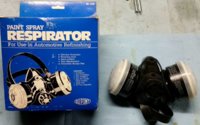This is the stuff:
https://www.amazon.com/Valspar-4432-10-Deere-Tractor-Implement/dp/B000I1ASPS?th=1 but you've to make sure you get the hardener and mix it properly:
https://www.amazon.com/Valspar-4625-Enamel-Hardener-oz/dp/B000LNY1MY/ref=sr_1_1?s=automotive&ie=UTF8&qid=1510335261&sr=1-1&keywords=valspar+enamel+hardener&dpID=41%2BcMN3stNL&preST=_SY300_QL70_&dpSrc=srch. I used foam brushes (you can buy a very large bag on Amazon with various sizes for cheap. I'm sure there are better options for brushes, but this worked well.
The advantage here is that the nasty organic compounds are not aerosolized, so you don't have nearly as much risk inhaling them.
The carbon filter media does nothing to absorb or block the isocyanates. The BEST way to minimize risk is to simply avoid them. The only way to safely avoid them is to use a GOOD positive pressure respirator and be upwind of the media (outdoors with a small breeze, paint booth with a cross or down draft, etc.). At my last job, I was the corporate safety officer and dealt with hazardous metal powder (10 - 45 micron sized aluminum, titanium, etc.) which was a major health concern (could be readily absorbed through the skin, nasty nasty nasty in inhaled, explosive, flammable, etc.) and the only way I would allow anyone to use our powders was to wear a PAPR (
https://www.amazon.com/3M-Versaflo-Heavy-Industry-TR-300-HIK/dp/B007PB4C38) system.
I used to use the PAPR if spraying ANY kind of paint, especially 2-part ones, as it was a good habit to be in, and I don't like the smell of spray paint much. Dang company made me return the respirator when I left the company, even though I had 18 months of use with it and had Lord knows how many "cooties" in it that couldn't be washed off. I was quite upset that it would just sit on a shelf unused...
Some good literature on the dangers of these paints:
http://www.safetyandhealthmagazine....in-the-workplace-exposure-effects-and-control



